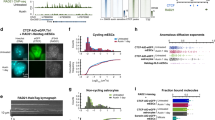Abstract.
Eukaryotic genomes have complex spatial organization in the nucleus. The factors and the mechanisms involved in this organization remain an enigma. Among the many proteins implicated in such a role, the ubiquitous Zn-finger protein CTCF stands out. Here we summarize the evidence placing CTCF in the enviable position of a master organizer of the genome. CTCF can form loops in cis, and can bridge sequences located on different chromosomes in trans. The thousands of CTCF binding sites, identified in recent genome-wide localization studies, and their distribution along the genome further support a crucial role of CTCF as a chromatin organizer.
Similar content being viewed by others
Author information
Authors and Affiliations
Corresponding author
Additional information
Received 10 October 2008; received after revision 11 December 2008; accepted 16 December 2008
Rights and permissions
About this article
Cite this article
Zlatanova, J., Caiafa, P. CCCTC-binding factor: to loop or to bridge. Cell. Mol. Life Sci. 66, 1647–1660 (2009). https://doi.org/10.1007/s00018-009-8647-z
Published:
Issue Date:
DOI: https://doi.org/10.1007/s00018-009-8647-z




